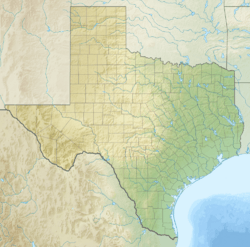Comal Power Plant facts for kids
Quick facts for kids |
|
|
Comal Power Plant
|
|

Comal Power Plant in 2012
|
|
| Location | 144 Landa St., New Braunfels, Texas |
|---|---|
| Area | 13.7 acres (5.5 ha) |
| Built | 1925 |
| Built by | United Gas Improvement Const. Co., Philadelphia |
| Architectural style | Classical Revival |
| NRHP reference No. | 04000895 |
| Added to NRHP | August 20, 2004 |
The Comal Power Plant was a large building in New Braunfels, Texas, that made electricity. It started being built in 1925. This power plant first used a type of coal called lignite to create power.
Later, in the 1970s, the plant stopped making electricity. It was recognized as an important historical place in 2004. Today, the old power plant building has been turned into apartments called The Landmark Lofts. When it was running at its busiest, the plant made enough electricity for many homes.
Contents
History of the Comal Power Plant
The Comal Power Plant was built close to the Comal Canal. This canal provided the water needed to cool the big machines inside the plant. The plant made electricity by burning fuel to create steam. This steam then spun large turbines and generators. It was not a hydroelectric plant, which uses water power directly.
The Comal Power Plant provided electricity to many places in central Texas. It also supplied power to several military bases nearby. This was especially important during World War II, when the United States War Department temporarily managed the plant.
Fuel Changes at the Plant
The plant was first designed to use lignite. Lignite is a type of coal that doesn't have as much energy as other coals. It was cheap, but it needed special ways to be shipped and prepared.
Around 1927, natural gas became available in the area. The plant then started changing its main fuel source to natural gas. It also used fuel oil as a backup. This change was finished by 1929. Using natural gas meant the plant needed fewer workers. The number of employees dropped from 135 to less than half of that.
During the Great Depression, the plant helped its workers. They shortened the work week from six days to five days. This allowed them to hire more people and help more families.
The Plant's Special Train
In 1925, a small steam locomotive was built for the company that ran the plant. This train was called a 0-4-0, which describes its wheel arrangement. It weighed about 23.5 tons.
This little train was only used for two years while the plant burned lignite coal. It helped move the coal around. After the plant switched to gas, the train was put on display at the power plant. It was often painted silver to help keep it from rusting.
The train had a very large air compressor and five air tanks. These were used to operate a special machine called a rotary car dumper. This machine would tip over train cars to unload the coal.
In the early 1960s, a group of volunteers started the Texas Transportation Museum. They were able to get the locomotive donated to their new museum. They moved it to old train tracks near the Pearl Brewery in San Antonio, Texas. There, they even got it running again and gave train rides! Today, this special train is fully fixed up and preserved. It gives regular train rides at the Texas Transportation Museum.
Closing Down
In the 1970s, there was an energy crisis. This caused the price of natural gas to go up a lot. It also made natural gas harder to find. When the plant's natural gas contract ended in early 1973, it had to switch to using only fuel oil.
Using fuel oil meant the plant needed more workers to keep it running. This made it very expensive to operate. Because of the high costs, the Comal Power Plant closed its doors on June 16, 1973.
After it closed, the large turbine generators and other equipment were sold. Some pieces were moved to other power plants in the late 1970s and 1980s. Eventually, any remaining equipment was taken apart and sold for scrap metal.



